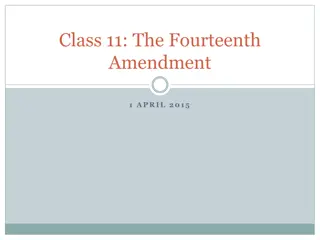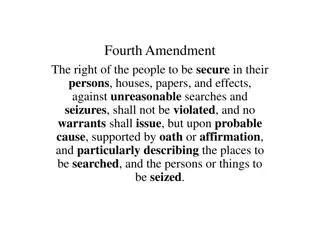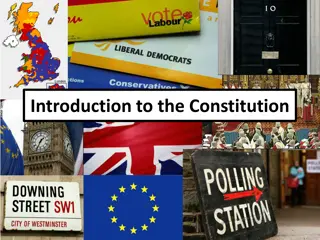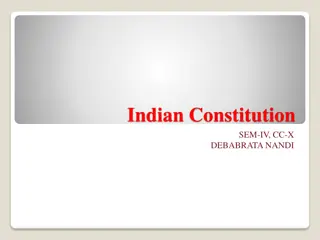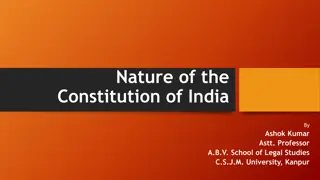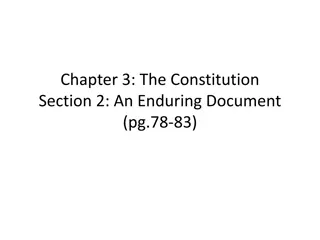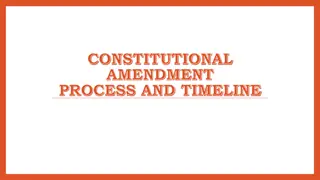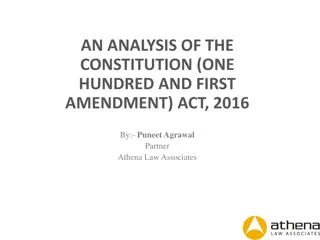Amendment Process in the Indian Constitution: Overview and Procedure
Amending the Indian Constitution is a crucial process outlined in Article 368. It is designed to maintain the sanctity of the Constitution and prevent arbitrary power. The process involves introducing a Bill, passing it with required majorities in both Houses of Parliament, ratifying by state legislatures, and obtaining the President's assent. The Constitution allows for different types of amendments and has a distinctive amending process compared to other nations.
Download Presentation

Please find below an Image/Link to download the presentation.
The content on the website is provided AS IS for your information and personal use only. It may not be sold, licensed, or shared on other websites without obtaining consent from the author. Download presentation by click this link. If you encounter any issues during the download, it is possible that the publisher has removed the file from their server.
E N D
Presentation Transcript
Amendment to the Indian Constitution Presented By Dr. Shamim Ahmad Wagey Department of Political science PG College Rajouri
Meaning Amending the Constitution of India is the process of making changes fundamental law or supreme law. The procedure of amendment in the constitution is laid down in Part XX (Article 368) of the Constitution of India. This procedure ensures Constitution of India and keeps a check on arbitrary power of the Parliament of India. to the nation's the sanctity of the
Procedure The Constitution of India provides for a distinctive amendment process when compared to the Constitutions of other nations. this can be described as partly flexible and partly rigid. The Constitution provides for a variety in the amending commended by Australian academic Sir Kenneth Wheare who felt that uniformity in the amending process imposed "quite unnecessary restrictions" upon the amendment of parts of a Constitution. An amendment of the Constitution introduction of a Bill in either House of Parliament. The Bill must then be passed in each House by a majority of the total membership of that House and by a majority of not less than two-thirds of the members of that House present and voting. There is no provision for a joint sitting in case of disagreement between the two Houses. The Bill, passed by the required majority, is then presented to the President who shall give his assent to the Bill. If the amendment seeks to make any change in any of the provisions mentioned in the provision to article 368, it must be ratified by the Legislatures of not less than one- half of the States. Although there is no prescribed time limit for ratification, it must be completed before the amending Bill is presented to the President for his assent. process. This feature has been can be initiated only by the
Types of amendments Article 368 provides for two types of amendments, that is, by a special majority of Parliament and also through the ratification of half of the states by a simple majority. But, some other articles provide for the amendment of certain Constitution by a simple majority of Parliament, that is, a majority of the members of each House present and voting (similar legislative process). Notably, these amendments are not deemed to be amendments of the Constitution for the purposes of Article 368. Amendment by simple majority of the Parliament Amendment by special majority of the Parliament Amendment by special majority of the Parliament and the ratification of at least half of the state legislatures. provisions of the to the ordinary
Role of state legislatures The role of the states in constitutional amendment is limited. State legislatures cannot initiate any Bill or proposal for amendment of the Constitution. They are associated in the process of the amendment only through the ratification procedure laid down in article 368, in case the amendment seeks to make any change in any of the provisions mentioned in the proviso to article 368. The only other provision for constitutional changes by state legislatures is to initiate the process for creating or abolishing Legislative Councils in their respective legislatures, and to give their views on a proposed Parliamentary bill seeking to affect the area, boundaries or name of any State or States which has been referred to them under the proviso to Article 3. However, this referral does not restrict Parliament's power to make any further amendments of the Bill
Role of Union territories Union territories have no say in constitutional amendments, including the ratification process which is only States. Delhi and Puducherry are two union territories that are constitutional amendments, to have an elected Legislative Assembly ministers, thereby enjoying partial statehood powers. Both of these territories can participate in the ratification process. open to entitled, by special and a Cabinet of
Thank you

 undefined
undefined

 undefined
undefined



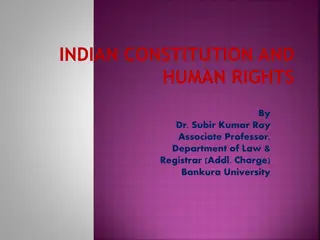
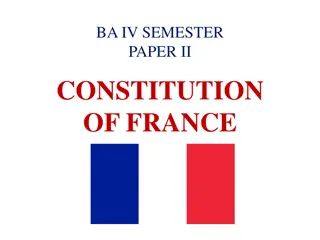


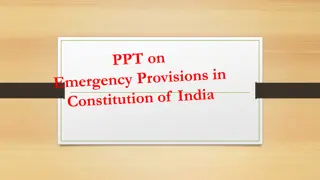

![Briefing on the Criminal Procedure Amendment Bill [B12-2021] to the Portfolio Committee on Justice and Correctional Services](/thumb/157093/briefing-on-the-criminal-procedure-amendment-bill-b12-2021-to-the-portfolio-committee-on-justice-and-correctional-services.jpg)
